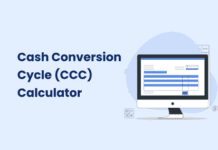Managing accounts receivable well is key to keeping cash flow healthy and improving working capital in finance. To track and improve accounts receivable performance, finance teams use key performance indicators (KPIs).
In this article, we’ll go over the top accounts receivable KPIs that every finance team should know. These KPIs, along with their calculation formulas, help finance teams track progress, find areas to improve, and achieve financial success.
What Is Accounts Receivable KPI?
Accounts Receivable KPIs are key metrics that help businesses measure how well they manage money owed to them. These KPIs give insights into the company’s financial health by tracking things like how quickly they collect payments, how long invoices are unpaid, and how well the accounts receivable process is working.
By keeping an eye on these KPIs, businesses can spot areas that need improvement, improve cash flow, and make better decisions to stay financially strong.
10 Accounts Receivable KPIs Every Finance Team Needs to Track
Days Sales Outstanding (DSO)
DSO represents the average number of days it takes for a company to collect payment after a sale has been made.
DSO = (Total Accounts Receivable / Total Credit Sales) x Number of Days
Why is it important?
It is a key measure of the effectiveness of an AR department. A lower DSO signifies that the company collects receivables more quickly, indicating efficient credit and collection processes.
How to optimize it?
- Set up payment terms with the customers beforehand to minimize late payments.
- Identify delinquent customers and analyze their payment trends.
Average Days Delinquent (ADD)
ADD is another essential accounts receivable KPI which provides a snapshot of how long, on average, invoices go unpaid past their due date.
ADD = (Total Overdue Receivables / Total Invoices Outstanding) x Number of Days
Why is it important?
It offers a perspective on the timeliness of payments. The lower the ADD, the better, as it implies that payments are being made closer to their due dates.
How to optimize it?
- Resolve any disputes before the payment due date.
- Proactively send dunning communication to customers.
Collections Effectiveness Index (CEI)
The CEI is a measure of the ability of the collections department to collect funds from customers.
CEI = [(Beginning Receivables + Monthly Credit Sales - Ending Total Receivables) / (Beginning Receivables + Monthly Credit Sales - Ending Current Receivables)] x 100
Why is it important?
This metric provides a clear picture of how well the company’s collection team obtains money from invoices. If a company’s CEI is low, it suggests that its collections process needs to be optimized.
How to optimize it?
- Get personalized dashboards to set custom rules to prioritize your collections worklist.
- Enable automated correspondence to reduce the time spent on customer follow-ups.
Accounts Receivable Turnover (ART) Ratio
ART ratio is the accounts receivable KPI that demonstrates how efficiently a company uses and manages the credit it extends to customers and how quickly that short-term debt is collected.
ART = Net Credit Sales / Average Accounts Receivable
Why is it important?
It helps a company know if they are being paid regularly and have positive cash flow. A high ART indicates that the company collects its receivables more frequently within the period.
How to optimize it?
- Sending invoices at the correct time will spur customers to pay promptly.
- Offer convenient payment options such as ACH, card payments, or electronic payments to customers.
Days Deduction Outstanding (DDO)
DDO measures your financial health, indicating how well your company can resolve deductions.
DDO= (Number of Open Deduction/ Average Value of Deduction) X Time Period
Why is it important?
It indicates a company’s ability to resolve disputes, investigate claims, and collect payments.
How to optimize it?
- Get a centralized space to access files related to deduction conveniently.
- Provide customers a portal for raising deduction claims with proper reason codes to free up time spent in examining and matching deductions with invoices.
Cash Conversion Cycle (CCC)
The cash conversion cycle looks at the amount of time needed to sell inventory, collect receivables, and pay bills without incurring penalties.
Cash Conversion Cycle = Days Sales Outstanding + Days Inventory Outstanding - Days Payable Outstanding
Why is it important?
It’s an indicator of operational efficiency, liquidity risk, and overall financial health for all companies that buy and manage inventory. Lower CCC is better and should be benchmarked with the industry standard.
How to optimize it?
- Calculate the metric at regular intervals.
- Modify policies to collect payments from customers faster.
Bad Debt to Sales Ratio (BDSR)
The BDSR measures the percentage of receivables that cannot be collected in a specific time frame.
Bad Debt to Sales Ratio= (Bad Debt / Total Credit Sales) x 100
Why is it important?
This data helps a company evaluate its accounts receivable process and ascertain its financial health. A lower ratio is preferable as it signifies a low level of uncollectable debt relative to sales.
How to optimize it?
- Review customer payment behavior to update credit policies frequently.
- Offer early payment discounts to collect payments faster.
Collection Costs
The collection costs denote the amount of money spent to collect each payment.
Collection Costs = Total Collection Expenses / Total Collections
Why is it important?
Collection costs reflect the efficiency of the collection process. Lower costs imply better efficiency.
How to optimize it?
- Ditch paper-based traditional processes.
- Automate payment reminders, customer statements, and so on.
Right Party Contact (RPC) Rate
The RPC rate is a crucial metrics that measures the percentage of contact attempts that were made to a valid contact from whom an invoice is due.
RPC Rate = (Number of Successful Right Party Contacts / Total Number of Attempts) x 100
Why is it important?
It tracks the effectiveness of the collections team in reaching the correct party. A higher RPC rate indicates more successful collection efforts.
How to optimize it?
- Create strong policies for customer onboarding.
- Maintain a centralized repository for all customer information.
Number of Revised Invoices
This accounts receivable KPI measures the accuracy of the billing process.
Number of Revised Invoices = Total Number of Invoices Sent – Total Number of Correct Invoices Sent
Why is it important?
It can help you identify areas where you need to improve and subsequently support your AR team with future cash collections. A lower number of revised invoices indicates better accuracy and less confusion for customers.
How to optimize it?
- Avoid manual AR processes to reduce errors.
- Ensure data is up to date and accurate.
Why Tracking Accounts Receivable KPIs Important for Businesses?
Tracking accounts receivable KPIs is important for businesses because it helps them understand their financial health and how well they are managing payments. By keeping an eye on metrics like the average time to collect payments, how often payments are collected, and the age of unpaid invoices, businesses can manage their cash flow better, spot any problems in getting paid, and make smart decisions to improve their receivables process.
Having a healthy amount of accounts receivable ensures that the business has enough money to cover expenses and invest in growth. Tracking these KPIs also helps businesses check if their credit policies are working and find customers who owe money, so they can act quickly to reduce bad debt and improve collections.
By tracking these KPIs, businesses can predict cash flow more accurately, lower bad debts, and improve overall financial performance. It also helps build good relationships with customers by making the payment process smooth and efficient.
Conclusion
Accounts receivable KPIs are key to managing AR effectively. They help quickly spot performance issues, take action when needed, and make better decisions. By understanding and regularly tracking these KPIs, teams can boost their performance, improve cash flow, and support the company’s overall financial health.
Like all metrics, these accounts receivable KPIs should be considered in light of the company’s industry, size, and past performance to make useful comparisons and drive real improvements.
Explore more about optimizing your financial performance with real-time, AI-powered reports. Access now and make accurate strategic decisions!
FAQ
Success in AR can be measured through KPIs such as DSO, percentage of overdue invoices, and CEI. Efficient AR processes should aim for a low DSO, a small percentage of overdue invoices, and a high CEI, indicating effective collections efforts.
Finance teams use intuitive dashboards with drill-down capabilities to monitor AR KPIs regularly. With real-time visibility, finance teams can track performance, address issues promptly, optimize collection processes, and ensure a healthy cash flow.









![Why AI Sales Calls Are Making Good Sales Reps Even Better [2025 Guide] ai sales calls](https://cdn-kmjmp.nitrocdn.com/YvtqmrsiHUxqerlSiZgbfzqqTARWTElr/assets/images/optimized/rev-834053b/blog.peakflo.co/wp-content/uploads/2025/09/65168cf6-3001-4733-8cbc-12d5684cf449-218x150.webp)

































